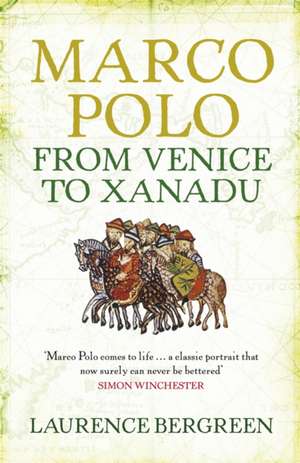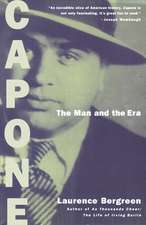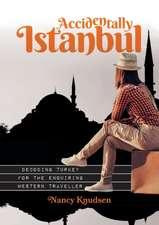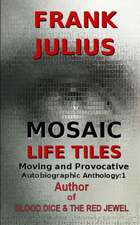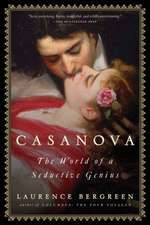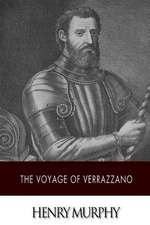Marco Polo
Autor Laurence Bergreenen Limba Engleză Paperback – 5 mar 2009
| Toate formatele și edițiile | Preț | Express |
|---|---|---|
| Paperback (2) | 73.63 lei 3-5 săpt. | +37.96 lei 10-14 zile |
| Quercus Books – 5 mar 2009 | 73.63 lei 3-5 săpt. | +37.96 lei 10-14 zile |
| Vintage Books USA – 31 oct 2008 | 156.62 lei 3-5 săpt. |
Preț: 73.63 lei
Preț vechi: 95.85 lei
-23% Nou
Puncte Express: 110
Preț estimativ în valută:
14.09€ • 14.62$ • 11.78£
14.09€ • 14.62$ • 11.78£
Carte disponibilă
Livrare economică 22 februarie-08 martie
Livrare express 11-15 februarie pentru 47.95 lei
Preluare comenzi: 021 569.72.76
Specificații
ISBN-13: 9781847247674
ISBN-10: 1847247679
Pagini: 464
Ilustrații: Illustrations, maps
Dimensiuni: 134 x 198 x 30 mm
Greutate: 0.38 kg
Editura: Quercus Books
Locul publicării:United Kingdom
ISBN-10: 1847247679
Pagini: 464
Ilustrații: Illustrations, maps
Dimensiuni: 134 x 198 x 30 mm
Greutate: 0.38 kg
Editura: Quercus Books
Locul publicării:United Kingdom
Notă biografică
Laurence Bergreen was born in New York City and educated at Harvard University. Now a prize-winning nonfiction writer, his books include Over the Edge of the World: Magellan's Terrifying Circumnavigation of the Globe (2004) and Voyage to Mars: NASA's Search for Life Beyond Earth, a narrative of NASA's exploration of Mars and the search for extraterrestrial life (2000).
Extras
Chapter One: The Merchants of Venice
Then all the charm
Is broken—all that phantom-world so fair
Vanishes, and a thousand circlets spread. . . .
She hid from her enemies amid a seductive array of islands, 118 in all. Damp, dark, cloistered, and crowded, she perched on rocks and silt. Fortifications and spectacular residences rose on foundations of pinewood piles and Istrian stone. In Marco Polo's Venice, few edifices—with the exception of one huge Byzantine basilica and other large churches—stood entirely straight; most structures seemed to rise uncertainly from the water.
Marco Polo came of age in a city of night edging toward dawn; it was opaque, secretive, and rife with transgressions and superstitions. Even those who had lived their entire lives in Venice became disoriented as they wandered down blind alleys that turned without warning from familiar to sinister. The whispers of conspiracy and the laughter of intimacy echoed through narrow passageways from invisible sources; behind dim windows, candles and torches flickered discreetly. In the evening, cobwebs of mist arose from the canals, imposing silence and isolation, obscuring the lanterns in the streets or in windows overlooking the gently heaving canals. Rats were everywhere—emerging from the canals, scurrying along the wharves and streets, gnawing at the city's fragile infrastructure, bringing the plague with them.
The narrow streets and passageways, some barely shoulder-width, took bewildering twists and turns until, without warning, they opened to the broad expanse of the Grand Canal, which divided one-half of the city from the other before running into the lagoon and, beyond that, the expanses of the Adriatic Sea.
In winter, the city hosted Carnival (literally, the playful "bidding farewell to meat" before Lent). Carnival became the occasion for orgies taking place just out of sight behind high courtyard walls and opaque curtains. Rumors of foul play ran rife amid the gaiety and sensuality of the Republic. Venetians bent on evil preferred quiet means of imposing death, such as poisoning or strangulation, and they usually got away with it.
In an uncertain world, thirteenth-century Venetians could feel certain of a few things. Two hundred years before Copernicus and three hundred before Galileo, it was an article of faith that the Sun revolved around the Earth, that the heavenly spheres were perfectly smooth, and that Creation occurred exactly 4,484 years before Rome was founded. Jerusalem was considered "the navel of the world." Entrances to Heaven and Hell existed, somewhere. The day, for most people, was subdivided into times for prayer: matins at midnight, lauds three hours later, prime at daybreak, terce at midmorning, sext at noon, none at midafternoon, vespers at sunset, and, at bedtime, compline. In the Age of Faith, science consisted largely but not entirely of spurious pursuits such as alchemy—the effort to transmute so-called base metals into gold—and astrology, which went hand in hand with astronomy.
People depended on wind, water, and animals for power. In Western Europe, coal had yet to be exploited as an energy source; paper money and the printing press also lay two hundred years in the future. The most advanced technology consisted of ships—considered a marvel of transport, though very dangerous—and devices capable of sawing wood, pressing olives, and tanning hides.
Throughout Europe, travel was exceedingly slow and hazardous. Crossing the English Channel was a dreaded undertaking; those who completed the ordeal would claim that the effort had impaired their health. Over land, people moved no faster than a horse could take them; the average land journey covered eight to ten miles a day, or under special circumstances, for brief durations, fifteen to twenty miles. Superstition led those who undertook such journeys to seek shelter at nightfall in primitive inns, infested with vermin, where two or three sojourners shared a single bed. It took five harrowing weeks to ride by cart from Paris to Venice.
But in Venice, conditions were very different. Tiny in size, yet global in outlook, Venice was entering the Late Middle Ages, a period of economic expansion, cultural achievement, and the lowering of barriers to commercial activity. Travel was not the exception, it was the norm. Everyone in Venice, it seemed, was a traveler and a merchant, or aspired to be. Across Europe, political power, formerly scattered among disorganized and crumbling empires reaching back to Roman times, had coalesced in well-armed and well-organized city-states, such as Venice. The growth in commerce among European city-states contributed to rapid advances in art, technology, exploration, and finance. The compass and clock, windmill and watermill—all vital to the smooth functioning of European economies—came into being, and great universities that survive to this day were being founded. As a result of all these advances, Venice—indeed, all of Europe as we know it—began to emerge.
Venice—seductive, Byzantine, and water-bound—was among the most important centers of commerce and culture in thirteenth-century Europe, a flourishing city-state that lived by trade. Her economy thrived thanks to her aggressive navy, which vigorously defended the city from repeated onslaughts by rapacious Genoese rivals and Arab marauders. Unlike other medieval cities, Venice had no walls or gates. They were not necessary. The lagoon and swamps protected Venice from invaders by land or by sea.
As the gateway to the riches of the East, Venice gave rise to a sophisticated merchant aristocracy, including the Polo family, known for frequent journeys to the East, especially Constantinople, in search of jewels, silks, and spices. Venice was highly structured, fiercely independent and commercial, and based on a unique combination of feudal obligation, and global outlook.
Because Venice was compact, hemmed in by the lagoon and by its enemies, the sense of common cause among its inhabitants was strong. "By virtually confining the Venetians to so restricted a space," says the historian John Julius Norwich, "it had created in them a unique spirit of cohesion and cooperation . . . not only at times of national crisis but also, and still more impressively, in the day-to-day handling of their affairs. Among Venice's rich merchant aristocracy everyone knew everyone else, and close acquaintance led to mutual trust of a kind that in other cities seldom extended far outside the family circle."
As a result, Venetians developed a reputation for efficient and thorough business administration—the most advanced in Europe. "A trading venture," Norwich says, "even one that involved immense initial outlay, several years' duration, and considerable risk, could be arranged on the Rialto in a matter of hours. It might take the form of a simple partnership between two merchants, or that of a large corporation of the kind needed to finance a full-sized fleet or trans-Asiatic caravan." Either way, Norwich concludes, "it would be founded on trust, and it would be inviolable."
The contractual underpinnings of a journey such as the one undertaken by the Polo family to China were a bit more formal than a mere handshake or oath. Marco Polo came of age in a city teeming with commerce. Venetian merchants had developed all sorts of strategies for dealing with the vagaries of their livelihood, global trade. In the absence of standard exchange rates, the many types of coins in use created a nightmare of conversion. The Byzantine Empire had its bezants, Arabic lands their drachmas, Florence its florins. Venice, relying on the ratio of gold to silver in a given coin to determine its true value, tried to accommodate them all. Merchants such as the Polos sought to circumvent the vexed system of coins, with its inevitable confusion and debasement, by trading in gems such as rubies and sapphires, and in pearls.
To meet these sophisticated and exotic financial needs, Venice developed the most advanced banking system in Western Europe. Banks of deposit on the Continent originated there. In 1156, the Republic of Venice became the first state since antiquity to raise a public loan. It also passed the first banking laws in Europe to regulate the nascent banking industry. As a result of these innovations, Venice offered the most advanced business practices in Europe.
Venice adapted Roman contracts to the needs of merchants trading with the East. Sophisticated sea-loan and sea-exchange contracts spelled out obligations between shipowners and merchants, and even offered insurance—mandatory in Venice beginning in 1253. The most widespread type of agreement among merchants was the commenda, or, in Venetian dialect, the collegantia, a contract based on ancient models. Loosely translated, the term meant "business venture," and it reflected prevailing customs of the trade rather than a set of consistent legal principles. Although these twelfth- and thirteenth-century contracts seem antiquated, they are startlingly modern in their calls for precise accounting. Contracts like these reflected and sustained a rudimentary form of capitalism long before the concept came into existence.
For Venetians, the world was startlingly modern in another way: it was "flat," that is to say, globally connected across boundaries and borders, both natural and artificial. They saw the world as a network of endlessly changing trade routes and opportunities extending over land and sea. By ship or caravan, Venetian merchants traveled to the four corners of the world in search of valuable spices, gems, and fabrics. Through their enterprise, minerals, salt, wax, drugs, camphor, gum arabic, myrrh, sandalwood, cinnamon, nutmeg, grapes, figs, pomegranates, fabrics (especially silk), hides, weapons, ivory, wool, ostrich and parrot feathers, pearls, iron, copper, gold dust, gold bars, silver bars, and Asian slaves all poured into Venice via complex trade routes from Africa, the Middle East, and Western Europe.
Even more exotic items flowed into the city aboard foreign galleys. Huge marble columns, pedestals, panels, and blocks piled up on the docks, having been taken from some ruined temple or civic edifice in Constantinopole, or another Greek or Egyptian city. These remnants of antiquity, the very headstones of dead or moribund civilizations, would wind up in an obscure corner of the Piazza San Marco, or on the façade of some ostentatious palazzo inhabited by a duke or a wealthy merchant of Venice.
The variety of goods moved Shakespeare to observe, through the character Antonio in The Merchant of Venice, that "the trade and profit of the city / Consisteth of all nations." Venetian trade was synonymous with globalization—another embryonic concept of the era. To extend their reach, Venetians formed partnerships with distant governments and merchants that cut across racial and religious divisions. Arabs, Jews, Turks, Greeks, and eventually the Mongols became trading partners with Venice even when they seemed to be political enemies. The Polos were not the first merchants to travel from Venice to Asia, but thanks to Marco Polo's exploits, they became the most celebrated.
Wherever Venetians went, they announced themselves with their distinctive accent and dialect, veneto. This tongue, like other Romance languages, was based on Latin, and it incorporated vocabulary, syntax, and pronunciation from other languages-some German and Spanish (in the form of the Castilian s, pronounced "th"), and some Croatian. There was even a little French thrown into the mix. There are lots of x's and z's in veneto, but almost no l's. Lord Byron, who claimed to have enjoyed two hundred women in Venice in as many consecutive evenings, called veneto a "sweet bastard Latin." To further complicate matters, veneto had numerous variants. The Polos of Venice would have strained to understand the dialect spoken elsewhere in the area by the inhabitants of Padua, Treviso, or Verona.
Some distinctive words in Marco Polo's world have leapt from veneto to English. Venetians of Polo's day bade each other ciao—or, to be more precise, s ciavo or s ciao vostro—which means, literally, "I am your slave." (The word came into the Venetian language from Croatian.) Gondola is another Venetian word, although it is not clear when the long, elegant, black vessel itself came into use. It is likely that in Marco Polo's day, a wide variety of small craft, including sailboats, rowboats, and galleys, jostled one another in the city's winding canals.
And "arsenal," or a place where weapons are manufactured and stored, entered the Venetian language by way of the Arabic term dar al sina'ah, meaning "workshop." When Europeans of Marco Polo's era employed this word, they meant the Arsenal in Venice, renowned as a center of shipbuilding. Here shipwrights operated an early assembly line devoted to turning out galleys at a furious rate from standardized, prefabricated components such as keels and masts. A Spanish visitor named Pero Tafur described the precisely choreographed activity devoted to launching the galleys: "out came a galley towed by a boat, and from the windows they came out to them, from one the cordage, from another the bread, from another the arms, and from another the ballistas and mortars, and so from all sides everything that was required. And when the galley had reached the end of the street all the men required were on board, together with the complement of oars, and she was equipped from end to end."
Tafur counted the launching of ten "fully-armed" galleys within a six-hour span: one new warship every thirty-six minutes. No wonder that the speed with which the Arsenal of Venice could turn a bare keel into fully rigged craft was admired throughout Europe. And commanders could have their galleys in any color they wanted—as long as it was black.
The Venetian manner, then as now, was correspondingly brusque, efficient, and commercial. It took a Venetian to possess the practical knowledge, the sophistication, and the confidence to finance large expeditions or caravans to the East, to deal profitably with Muslim and Orthodox Christian adversaries, and to manage complex partnerships. Venetian laws enforced the smooth operation of business. A merchant returning to Venice was legally required to present his partners with his accounts within one month, and to divide the profits forthwith. As a further incentive to trade, taxation in Venice was among the lowest in Europe, and merchants kept nearly all the profit they made.
Just about everyone in Venice engaged in commerce. Widows and orphans invested in merchant activity, and any young man without means could describe himself as a "merchant" simply by launching himself in business. Although the risks were great, riches beyond imagining lured the adventurous, the willing, and the foolish. Fortunes were made and lost overnight, and Venetian family fortunes were built on the success of a single trade expedition to Constantinople.
From the Hardcover edition.
Then all the charm
Is broken—all that phantom-world so fair
Vanishes, and a thousand circlets spread. . . .
She hid from her enemies amid a seductive array of islands, 118 in all. Damp, dark, cloistered, and crowded, she perched on rocks and silt. Fortifications and spectacular residences rose on foundations of pinewood piles and Istrian stone. In Marco Polo's Venice, few edifices—with the exception of one huge Byzantine basilica and other large churches—stood entirely straight; most structures seemed to rise uncertainly from the water.
Marco Polo came of age in a city of night edging toward dawn; it was opaque, secretive, and rife with transgressions and superstitions. Even those who had lived their entire lives in Venice became disoriented as they wandered down blind alleys that turned without warning from familiar to sinister. The whispers of conspiracy and the laughter of intimacy echoed through narrow passageways from invisible sources; behind dim windows, candles and torches flickered discreetly. In the evening, cobwebs of mist arose from the canals, imposing silence and isolation, obscuring the lanterns in the streets or in windows overlooking the gently heaving canals. Rats were everywhere—emerging from the canals, scurrying along the wharves and streets, gnawing at the city's fragile infrastructure, bringing the plague with them.
The narrow streets and passageways, some barely shoulder-width, took bewildering twists and turns until, without warning, they opened to the broad expanse of the Grand Canal, which divided one-half of the city from the other before running into the lagoon and, beyond that, the expanses of the Adriatic Sea.
In winter, the city hosted Carnival (literally, the playful "bidding farewell to meat" before Lent). Carnival became the occasion for orgies taking place just out of sight behind high courtyard walls and opaque curtains. Rumors of foul play ran rife amid the gaiety and sensuality of the Republic. Venetians bent on evil preferred quiet means of imposing death, such as poisoning or strangulation, and they usually got away with it.
In an uncertain world, thirteenth-century Venetians could feel certain of a few things. Two hundred years before Copernicus and three hundred before Galileo, it was an article of faith that the Sun revolved around the Earth, that the heavenly spheres were perfectly smooth, and that Creation occurred exactly 4,484 years before Rome was founded. Jerusalem was considered "the navel of the world." Entrances to Heaven and Hell existed, somewhere. The day, for most people, was subdivided into times for prayer: matins at midnight, lauds three hours later, prime at daybreak, terce at midmorning, sext at noon, none at midafternoon, vespers at sunset, and, at bedtime, compline. In the Age of Faith, science consisted largely but not entirely of spurious pursuits such as alchemy—the effort to transmute so-called base metals into gold—and astrology, which went hand in hand with astronomy.
People depended on wind, water, and animals for power. In Western Europe, coal had yet to be exploited as an energy source; paper money and the printing press also lay two hundred years in the future. The most advanced technology consisted of ships—considered a marvel of transport, though very dangerous—and devices capable of sawing wood, pressing olives, and tanning hides.
Throughout Europe, travel was exceedingly slow and hazardous. Crossing the English Channel was a dreaded undertaking; those who completed the ordeal would claim that the effort had impaired their health. Over land, people moved no faster than a horse could take them; the average land journey covered eight to ten miles a day, or under special circumstances, for brief durations, fifteen to twenty miles. Superstition led those who undertook such journeys to seek shelter at nightfall in primitive inns, infested with vermin, where two or three sojourners shared a single bed. It took five harrowing weeks to ride by cart from Paris to Venice.
But in Venice, conditions were very different. Tiny in size, yet global in outlook, Venice was entering the Late Middle Ages, a period of economic expansion, cultural achievement, and the lowering of barriers to commercial activity. Travel was not the exception, it was the norm. Everyone in Venice, it seemed, was a traveler and a merchant, or aspired to be. Across Europe, political power, formerly scattered among disorganized and crumbling empires reaching back to Roman times, had coalesced in well-armed and well-organized city-states, such as Venice. The growth in commerce among European city-states contributed to rapid advances in art, technology, exploration, and finance. The compass and clock, windmill and watermill—all vital to the smooth functioning of European economies—came into being, and great universities that survive to this day were being founded. As a result of all these advances, Venice—indeed, all of Europe as we know it—began to emerge.
Venice—seductive, Byzantine, and water-bound—was among the most important centers of commerce and culture in thirteenth-century Europe, a flourishing city-state that lived by trade. Her economy thrived thanks to her aggressive navy, which vigorously defended the city from repeated onslaughts by rapacious Genoese rivals and Arab marauders. Unlike other medieval cities, Venice had no walls or gates. They were not necessary. The lagoon and swamps protected Venice from invaders by land or by sea.
As the gateway to the riches of the East, Venice gave rise to a sophisticated merchant aristocracy, including the Polo family, known for frequent journeys to the East, especially Constantinople, in search of jewels, silks, and spices. Venice was highly structured, fiercely independent and commercial, and based on a unique combination of feudal obligation, and global outlook.
Because Venice was compact, hemmed in by the lagoon and by its enemies, the sense of common cause among its inhabitants was strong. "By virtually confining the Venetians to so restricted a space," says the historian John Julius Norwich, "it had created in them a unique spirit of cohesion and cooperation . . . not only at times of national crisis but also, and still more impressively, in the day-to-day handling of their affairs. Among Venice's rich merchant aristocracy everyone knew everyone else, and close acquaintance led to mutual trust of a kind that in other cities seldom extended far outside the family circle."
As a result, Venetians developed a reputation for efficient and thorough business administration—the most advanced in Europe. "A trading venture," Norwich says, "even one that involved immense initial outlay, several years' duration, and considerable risk, could be arranged on the Rialto in a matter of hours. It might take the form of a simple partnership between two merchants, or that of a large corporation of the kind needed to finance a full-sized fleet or trans-Asiatic caravan." Either way, Norwich concludes, "it would be founded on trust, and it would be inviolable."
The contractual underpinnings of a journey such as the one undertaken by the Polo family to China were a bit more formal than a mere handshake or oath. Marco Polo came of age in a city teeming with commerce. Venetian merchants had developed all sorts of strategies for dealing with the vagaries of their livelihood, global trade. In the absence of standard exchange rates, the many types of coins in use created a nightmare of conversion. The Byzantine Empire had its bezants, Arabic lands their drachmas, Florence its florins. Venice, relying on the ratio of gold to silver in a given coin to determine its true value, tried to accommodate them all. Merchants such as the Polos sought to circumvent the vexed system of coins, with its inevitable confusion and debasement, by trading in gems such as rubies and sapphires, and in pearls.
To meet these sophisticated and exotic financial needs, Venice developed the most advanced banking system in Western Europe. Banks of deposit on the Continent originated there. In 1156, the Republic of Venice became the first state since antiquity to raise a public loan. It also passed the first banking laws in Europe to regulate the nascent banking industry. As a result of these innovations, Venice offered the most advanced business practices in Europe.
Venice adapted Roman contracts to the needs of merchants trading with the East. Sophisticated sea-loan and sea-exchange contracts spelled out obligations between shipowners and merchants, and even offered insurance—mandatory in Venice beginning in 1253. The most widespread type of agreement among merchants was the commenda, or, in Venetian dialect, the collegantia, a contract based on ancient models. Loosely translated, the term meant "business venture," and it reflected prevailing customs of the trade rather than a set of consistent legal principles. Although these twelfth- and thirteenth-century contracts seem antiquated, they are startlingly modern in their calls for precise accounting. Contracts like these reflected and sustained a rudimentary form of capitalism long before the concept came into existence.
For Venetians, the world was startlingly modern in another way: it was "flat," that is to say, globally connected across boundaries and borders, both natural and artificial. They saw the world as a network of endlessly changing trade routes and opportunities extending over land and sea. By ship or caravan, Venetian merchants traveled to the four corners of the world in search of valuable spices, gems, and fabrics. Through their enterprise, minerals, salt, wax, drugs, camphor, gum arabic, myrrh, sandalwood, cinnamon, nutmeg, grapes, figs, pomegranates, fabrics (especially silk), hides, weapons, ivory, wool, ostrich and parrot feathers, pearls, iron, copper, gold dust, gold bars, silver bars, and Asian slaves all poured into Venice via complex trade routes from Africa, the Middle East, and Western Europe.
Even more exotic items flowed into the city aboard foreign galleys. Huge marble columns, pedestals, panels, and blocks piled up on the docks, having been taken from some ruined temple or civic edifice in Constantinopole, or another Greek or Egyptian city. These remnants of antiquity, the very headstones of dead or moribund civilizations, would wind up in an obscure corner of the Piazza San Marco, or on the façade of some ostentatious palazzo inhabited by a duke or a wealthy merchant of Venice.
The variety of goods moved Shakespeare to observe, through the character Antonio in The Merchant of Venice, that "the trade and profit of the city / Consisteth of all nations." Venetian trade was synonymous with globalization—another embryonic concept of the era. To extend their reach, Venetians formed partnerships with distant governments and merchants that cut across racial and religious divisions. Arabs, Jews, Turks, Greeks, and eventually the Mongols became trading partners with Venice even when they seemed to be political enemies. The Polos were not the first merchants to travel from Venice to Asia, but thanks to Marco Polo's exploits, they became the most celebrated.
Wherever Venetians went, they announced themselves with their distinctive accent and dialect, veneto. This tongue, like other Romance languages, was based on Latin, and it incorporated vocabulary, syntax, and pronunciation from other languages-some German and Spanish (in the form of the Castilian s, pronounced "th"), and some Croatian. There was even a little French thrown into the mix. There are lots of x's and z's in veneto, but almost no l's. Lord Byron, who claimed to have enjoyed two hundred women in Venice in as many consecutive evenings, called veneto a "sweet bastard Latin." To further complicate matters, veneto had numerous variants. The Polos of Venice would have strained to understand the dialect spoken elsewhere in the area by the inhabitants of Padua, Treviso, or Verona.
Some distinctive words in Marco Polo's world have leapt from veneto to English. Venetians of Polo's day bade each other ciao—or, to be more precise, s ciavo or s ciao vostro—which means, literally, "I am your slave." (The word came into the Venetian language from Croatian.) Gondola is another Venetian word, although it is not clear when the long, elegant, black vessel itself came into use. It is likely that in Marco Polo's day, a wide variety of small craft, including sailboats, rowboats, and galleys, jostled one another in the city's winding canals.
And "arsenal," or a place where weapons are manufactured and stored, entered the Venetian language by way of the Arabic term dar al sina'ah, meaning "workshop." When Europeans of Marco Polo's era employed this word, they meant the Arsenal in Venice, renowned as a center of shipbuilding. Here shipwrights operated an early assembly line devoted to turning out galleys at a furious rate from standardized, prefabricated components such as keels and masts. A Spanish visitor named Pero Tafur described the precisely choreographed activity devoted to launching the galleys: "out came a galley towed by a boat, and from the windows they came out to them, from one the cordage, from another the bread, from another the arms, and from another the ballistas and mortars, and so from all sides everything that was required. And when the galley had reached the end of the street all the men required were on board, together with the complement of oars, and she was equipped from end to end."
Tafur counted the launching of ten "fully-armed" galleys within a six-hour span: one new warship every thirty-six minutes. No wonder that the speed with which the Arsenal of Venice could turn a bare keel into fully rigged craft was admired throughout Europe. And commanders could have their galleys in any color they wanted—as long as it was black.
The Venetian manner, then as now, was correspondingly brusque, efficient, and commercial. It took a Venetian to possess the practical knowledge, the sophistication, and the confidence to finance large expeditions or caravans to the East, to deal profitably with Muslim and Orthodox Christian adversaries, and to manage complex partnerships. Venetian laws enforced the smooth operation of business. A merchant returning to Venice was legally required to present his partners with his accounts within one month, and to divide the profits forthwith. As a further incentive to trade, taxation in Venice was among the lowest in Europe, and merchants kept nearly all the profit they made.
Just about everyone in Venice engaged in commerce. Widows and orphans invested in merchant activity, and any young man without means could describe himself as a "merchant" simply by launching himself in business. Although the risks were great, riches beyond imagining lured the adventurous, the willing, and the foolish. Fortunes were made and lost overnight, and Venetian family fortunes were built on the success of a single trade expedition to Constantinople.
From the Hardcover edition.
Recenzii
“Sumptuous. . . . A full-blooded rendition of Polo's astonishingh journey. . . . Richly researched and vividly conveyed.” —The Washington Post Book World“Fascinating. . . . Richly detailed and illuminating, a window into the most exotic of places and times.” —The Philadelphia Inquirer“As enthralling as a rollicking travel journal. . . . The world [Polo] encountered was stranger than any fable.” —The New York Times Book Review “With his polished, authoritative storytelling, Bergreen makes the world of Marco Polo very permanent.” —Entertainment Weekly
